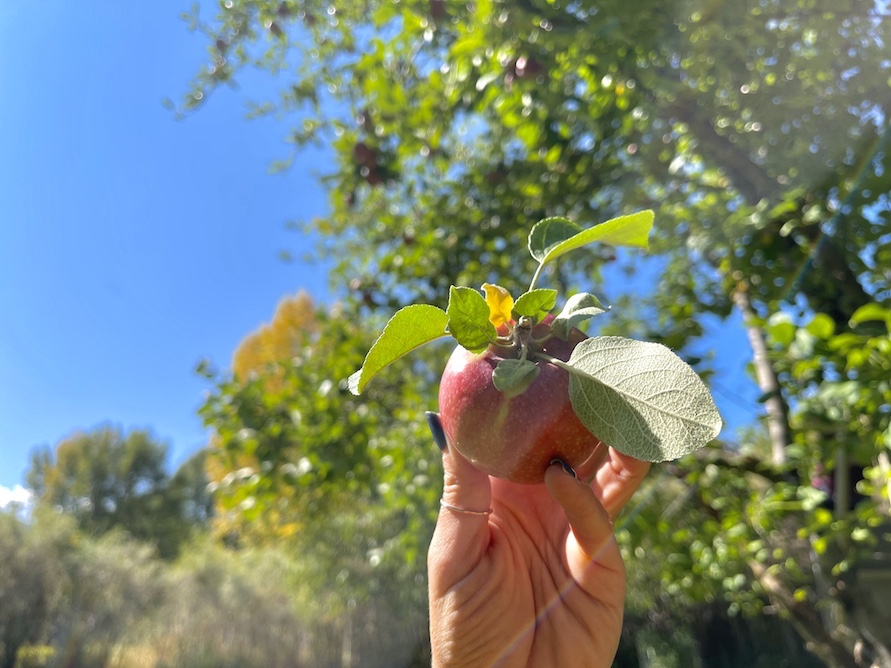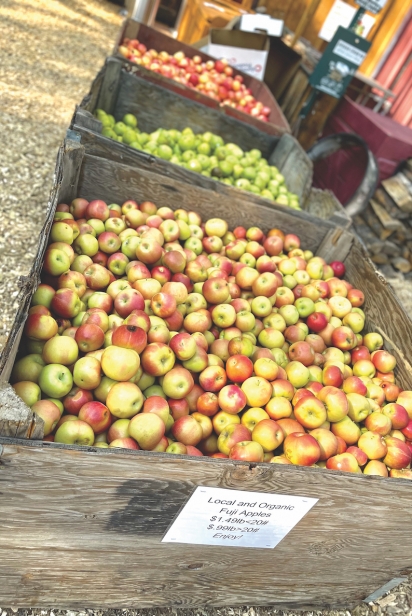The Future of Fruit
“As a society, we need to start asking some genuine questions about the value of being able to have food,” says Regan Choi, who helps run Ela Family Farms in Hotchkiss with fourth-generation orchardist Steve Ela.
It’s fall, the last glowing peach of the year has been eaten, and we’re discussing how orchardists in Colorado have been impacted by climate change. Being stewards of a perennial crop that takes years to mature, fruit tree growers don’t have the option to uproot to find a friendlier climate.
Her response is a sobering reframe. It’s clear that the challenges faced by orchardists across our region will not be solved solely by buying local. Food and climate are now inherently globalized issues, raising some bigger questions: “Do we want to rely on transnational food-supply chains? As we saw from COVID, the supply chains break down,” says Choi. “Or do we want to be able to grow food in the United States, close to our communities that need to be fed no matter what’s happening in the world?”
A hard frost begs tough questions
These questions become more urgent every year. The Rocky Mountain climate provides plenty of the chill hours many fruit trees require to produce fruit, and it’s normal for Colorado orchardists to worry about early spring frosts killing the first sets of blossoms destined to become that year’s crop. But in October 2020, western Colorado’s weather stayed unseasonably warm late into the month. Normally, “those first nights below freezing are what let the tree know it’s time to go to sleep” (go dormant for the winter), explains Gwen Cameron of Rancho Durazno, a father-daughter-run orchard in Palisade. Instead, the warm weather lulled the trees into staying awake.
One night, a cold snap hit the region unlike anything seen in 60 years. In Hotchkiss, temperatures plunged from 80 to just 3 degrees in less than 24 hours. After a sleepless night, Choi and Ela knew there’d been serious damage, but it wasn’t until spring that they, and other orchardists across the region, could assess it fully. Whole orchards of trees had died, resulting in the loss of millions of pounds of fruit and a harvest of only 25 percent of their normal years.
The loss of mature trees is a profound kind of loss. Repercussions extend well beyond the next harvest to nearly a decade of setbacks, as newly planted trees take four to nine years to even start producing. So, in addition to investing in thousands of new trees, orchardists don’t see a return on that investment for years, while sustaining maintenance costs whether trees are producing fruit or not. Combined with climate variability, the risk of losing the sensitive young trees again will only increase.
In recent years, many orchardists have been asking themselves if it even makes sense to replant. Among those interviewed for this article, so far the answer has been yes, even though crops like cherries, which are more sensitive to frost than apples, may no longer have a place in the increasingly volatile western Colorado climate.
“I’m still inspired every day to do what we do,” says Harrison Topp of Topp Fruits, a family-run orchard in Hotchkiss and Paonia.
Resilient and adaptable, but in need of larger-scale change
Everyone is searching for ways to adapt. Topp describes using practices like mulch, fungal solutions, and compost teas to improve soil quality and fortify root systems, which help make younger trees more resilient to shocks. “We’re really an all-solutions kind of farm, trying everything we can to make sure that we’re getting the trees ready,” he says.
Colorado has been home to innovative and determined fruit-tree growers since over 120 years ago, when pioneers first took the risks necessary to produce here, encountering failures until they succeeded in adapting to the area’s extreme climate. Remnants of those historic orchards can be seen in agricultural zones across the state.
“As farmers, even without climate change, we are used to adapting,” Cameron notes. “We have frosts, pests, disease … We come up against new challenges and change. There’s a certain level of resiliency just inherent to being a farmer.”
But climate change impacts are nuanced, intricate, and unlike anything they’ve seen before. Cameron tells of having to pull workers from the fields because of poor air quality from wildfires. Fires and subsequent mudslides created multiple road closures, adding five to eight hours to their drive to markets for months. Due to longer and warmer summers, Choi and Ela describe having an additional life cycle of pest outbreaks and stressed trees that are more vulnerable to disease.
When I ask if they’re trialing more climate-resilient tree varieties, all the orchardists balk. Jeni Nagle of Ela Family Farms shares that the time, land, and money it takes to experiment on a large-enough scale to produce meaningful results is not feasible. Instead, they speak to a core issue for many small-scale agriculturalists: “The biggest thing would be to have financial stability for our farmers,” says Choi, “to not have the constant struggle just to survive from year to year. Then, we’d need the room to plant new varieties and be able to try new programs and expand in different ways that actually can shift as rapidly as the climate is changing.”
With the ongoing drought, less and less water is allocated to agriculture each year. While many orchardists are already set up to be as drought tolerant as possible, fruit needs a certain amount of water to size up into something edible and sellable. “That’s another big question for our state representatives. They say they’re saving water for us, but they’re not,” says Choi. “Like, new [housing] developments are still allowed to have lawns? That type of policy could really make a difference for us.”
Topp echoes the sentiment. While agriculture is often quoted as using 85 percent of the state’s water, he urges us to remember that in turn we consume that water in the form of food, an essential element of human life.
Even in the midst of these dark times, there is joy. Grief lifts from their faces when I ask them about their favorite fruit, to which they all have passionate replies.
“How can you not just love a peach that’s juicy, dripping down your chin?” says Choi. “Or plums—there are these tiny Japanese yellow plums that when ripe are like a SweeTART. But the elephant heart plums! You slice it and it looks like stained glass, holding it up to the sun ...” I have to cut them off from describing each and every fruit.
As orchardists have done for more than a century, these farmers will adapt, while prioritizing feeding their communities. But when it’s the future of all of our food that’s on the line, perhaps the real question is: Are we asking too much of farmers to shoulder the entire risk, investment, and burden of adapting to climate change? What would it look like if society prioritized and offered real support to the people who sustain our local food systems?
Because they prioritize us. When they talk about their communities, the orchardists speak of love, and tears come to their eyes. The farmers at Ela Family Farms choke up when describing the outpouring of emotional and financial support they received when they had to shutter their CSA.
“Hundreds of people kept saying things like, ‘We realize we actually need someone to grow our food. This has got to be so stressful,’” says Choi. “It was amazing to just have real understanding, to be seen by the people we’ve built relationships with for decades. That’s been the biggest piece keeping me going.”
This article is sponsored by CORE, the Community Office for Resource Efficiency. Since 1994, CORE has been helping Roaring Fork Valley residents save energy and cut carbon emissions to mitigate climate change. Edible Aspen is proud to partner with CORE—whose innovative leadership includes the nation’s first carbon-mitigation fee and one of its earliest solar rebate programs—on communication about climate issues. Article sponsorship contributes to the cost of producing the content; the sponsor has no editorial involvement.






